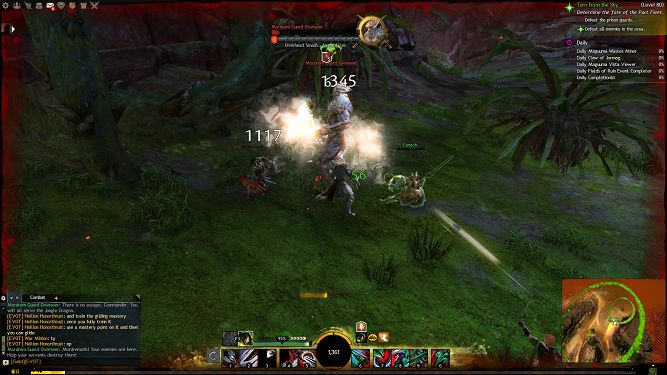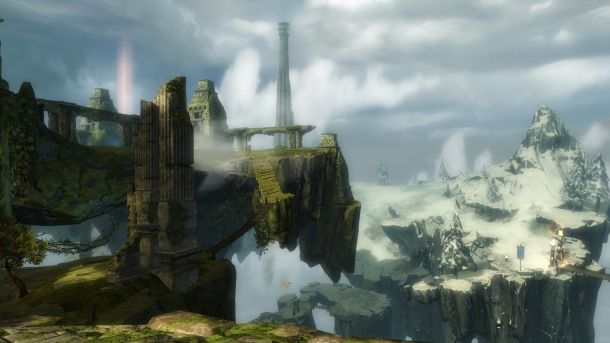Despite both games being developed by ArenaNet and set in the world of Tyria, Guild Wars and Guild Wars 2 are entirely different beasts. Guild Wars, while technically considered an MMORPG, lacked in many of the areas that typically define the genre by not having a persistent, open world where players could interact with each other. Instead the game was setup in a number of instanced staging areas that slowly guided players around Tyria and allowed for a limited number of players to engage each battle.
In stark contrast, Guild Wars 2 was developed like the typical MMORPG and allows hundreds of players to interact in both the cities and the wilderness. While this drastic change in gameplay did open up the franchise to a wave of new users, it also received a negative response from many dedicated players of the original game. However, the recent Heart of Thorns expansion has improved upon many of the criticized aspects while adding additional depth to the game.
Guild Wars vs Guild Wars 2
Story – Guild Wars
Guild Wars tells its story in a completely different fashion from its successor and it does so in a much more dramatic way. Besides pre-searing Ascalon, there’s no stringing the player along for a promise of more interesting content. Every mission brings an exciting new experience to the player and doesn’t stop until the campaign is complete. Furthermore, the game offers four separate storylines throughout its various expansions that traverse three different continents. Each one is completely unique, with the exception of Eye of the North as it extends to the story of the original Guild Wars campaign.
On the other hand, Guild Wars 2 spoon feeds players small drops of story as they level up. The initial personal story is weak and overall not interesting or even relevant to what’s going on in the game. Sure, it sucks that your parents went missing, but I’d much rather be fighting off Charr with Prince Rurik at my side than deal with politicians trying to make Queen Jennah look bad. Near the end of Guild Wars 2 things do get pretty intense while fighting the elder dragon’s minions, but afterwards the living story definitely falls off again. Heart of Thorns picks up the pace intensely, but most veteran players will have already suffered through the original content.
Casual PvE – Guild Wars 2
When it comes to general purpose leveling, questing, and endgame casual content, Guild Wars 2 wins this hands down. This is mostly due to the sheer amount of different things to do and most of them not being all that difficult. Before Heart of Thorns, the only challenging PvE content was high-level fractals. Most dungeons were relatively easy, the world bosses were about zerging, and it was possible for anyone to farm crafting material. Since the expansion’s release, there are even more things to do and grinding masteries makes it all even more enjoyable.
Conversely, Guild Wars had almost no casual content once the storyline was complete. All endgame content required a competent group of players, a specific class and build, or learning very specific strategies. Eventually, it was possible for less skilled players to farm some content with the addition of Hero characters, but the really difficult stuff was still off limits to all but the best.
Endgame PvE – Guild Wars
It might be a little unfair to judge Guild Wars 2 before raids have been released, but even if they’re great I don’t foresee them surpassing the challenging group content in the original. Areas like the Fissure of Woe, Domain of Anguish, Underworld and Urgoz’s Warren were some of the most difficult instances I’ve ever faced in an MMO to date. On release, most of these dungeons were simply unbeatable without a specific team composition full of highly-skilled players. Eventually, things were toned down a bit, but each was difficult and offered rewards worthy of the challenge.
In Guild Wars 2, there’s simply nothing difficult about PvE. High level fractals are more about having the right gear than offering a skill-based encounter and dungeons were essentially turned into farming areas. Hopefully, raids will finally add an element that hardcore PvE players are looking for, but one or two good raids won’t make up for everything else the game lacks.
Player vs Player – Guild Wars
With Random Arenas, Alliance Battles, Jade Quarry, Fort Aspenwood, Codex Arena, Heroes’ Ascent, and Guild versus Guild combat, Guild Wars still has the best PvP variety of any MMORPG out there. The only thing it’s missing is open-world combat, but that’s not something the game was ever designed to handle. Battlegrounds like the Random Arenas and Jade Quarry offered intense, quick bursts of action while Heroes’ Ascent and Guild versus Guild required dedication and highly-coordinated levels of play.
Guild Wars 2 does add that open-world element through World versus World, but unfortunately has a tendency to result in a massive zerg. Since all players interested in open world PvP are huddled into one battleground, it eliminates any true ganking and generally stifles small group PvP. That being said, with the right commander it can be a ton of fun to storm an enemy castle or run through the Edge of the Mists. Structured PvP is only a shell of its former self when compared to Guild Wars and has regressed to capture point holding instead of true PvP action. The addition of Stronghold has made structured PvP a little more interesting with its MOBA style gameplay, but overall it still falls short.
Skill Complexity - Guild Wars
Whenever I have to narrow it down to one thing that I wish Guild Wars 2 brought over from the original game it is skill diversity. In the original game, each profession could utilize a secondary profession and have access to all of its skills. While many skills were entirely usable, there were more than 1000 different skill options that any character could choose from. Characters in Guild Wars 2 have around 75 since the addition of Heart of Thorns with new weapons and trait skills.
It’s not just the amount of skills, however, it’s the quality. To be honest, most of the skills in Guild Wars were pretty useless. There were often unique builds that would occasionally find ways to utilize the abilities that weren’t often used, but most professions only had a handful of viable builds. There are probably just as many viable builds in Guild Wars 2 as there were during any significant meta in Guild Wars.
The biggest difference is what the skills do. In Guild Wars 2, everything is about doing damage, stopping damage or healing damage. In contrast, Guild Wars had some of the most unique abilities out there. Things like Diversion dramatically increased enemy cooldowns and Blackout, which temporarily disabled all of your skills and the enemy’s skill simultaneously. Furthermore, conditions like Blind, Deep Wound and interrupt played a much more intricate part in many builds instead of being stacked onto another damage skill. The introduction of the trait system dramatically improved skill meaningfulness in Guild Wars 2, but it still has a long way to go.
Graphics - Guild Wars 2
This is pretty much a freebie for Guild Wars 2. Both games have a very similar artistic style, but after 9 years the original game is starting to show its age. Regardless, Guild Wars 2 is one of the most beautiful MMORPGs on the market, even though it’s not the newest anymore. The only titles I can think of that are more aesthetically pleasing are Black Desert Online and Final Fantasy XIV: A Realm Reborn. The game is simply like walking through a living painting.
Crafting – Guild Wars 2
Another easy win for Guild Wars 2. This is mostly due to the fact that Guild Wars doesn’t really have a crafting system. All players need to do is gather the required material and find the appropriate vendor. While some of these might be in challenging to find locations, this doesn’t make the act of building armor any more interesting. Thankfully, crafting in Guild Wars 2 isn’t painfully time consuming or expensive and a profession can be completed in an afternoon for a few gold. Having a high-level profession is necessary for obtaining many Ascended and Legendary items in the game.
Combat - Guild Wars 2
Although Guild Wars wins hands down when it comes to diversity of skills, Guild Wars 2 has it beat when it comes to using them. The original game was all about memorizing rotations and knowing when to use specific skills. The latter, however, plays much more like an action RPG and utilizes ground target and area-of-effect skills, which adds another level of depth to the combat. It also helps that Guild Wars 2 has a functional vertical axis, which allows players to actually jump in addition to providing other tactical functions.
Guilds – Guild Wars 2
Hold on a minute. Guild Wars 2 doesn’t even have guild versus guild battles, so how can it possibly win this category? The thing is, in Guild Wars, guilds were either the most important aspect of the game or had no meaning at all. The only function for guilds was one game mode in PvP. Of course, that is one of the best PvP modes ever created, but they really had no other impact on the rest of the game.
In Guild Wars 2, however, guilds bring all kinds of players together for multiple different game modes. Guilds can hold and claim objectives in world versus world, field official PvP teams, and participate in all kinds of events. With the recent addition of guild halls, there’s finally some ownership in belonging to a guild. Even though there’s no official guild versus guild mode, something similar can be setup in guild halls. Finally, guilds are actually about being part of a community, whether it’s structured PvP or casual PvE.
Victor – Guild Wars 2
While Guild Wars 2 does technically win by points, there’s no clear champion. Both games cater to completely different audiences and excel in very different areas. Where Guild Wars is great when it comes to competitive PvP and challenging endgame content, Guild Wars 2 is accessible to a much larger audience and allows them to enjoy the game in almost any way they want. It seems the real winner here is ArenaNet, which has managed to build two excellent games over the last decade.




